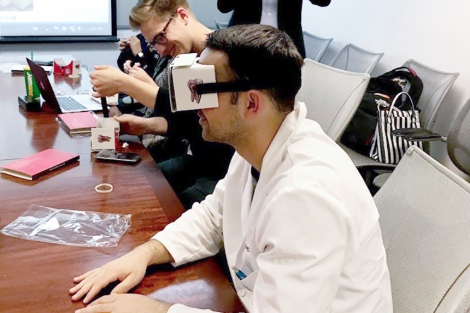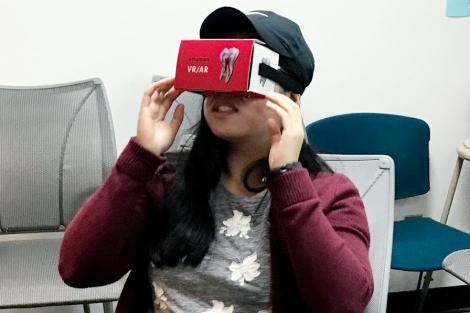With Virtual Reality, Dentistry Students Zoom Through 3-D Teeth
By Mitzi Baker on September 27, 2018
UCSF School of Dentistry student Steven Gigli tests the virtual-reality system that allows users to see teeth up close and in 3-D.
The students won’t be shrinking down in a magic school bus, but they will be able to zoom through a mouth and get a close-up, 3-D view of teeth – using virtual reality.
The technology, which is becoming mainstream for gaming and other education, is entering dental education to help students visualize every part of teeth and their spatial relationships.
“What is really cool about this new technology in our curriculum is that we can have a tooth right in front of us and see it in ways that can’t ever be conveyed through traditional two-dimensional images,” said Jerry Liu, a second-year student at UC San Francisco’s School of Dentistry.
Beyond 2-D in Textbooks
The traditional approach for dental students learning about teeth before seeing real patients was to look at them in two dimensions in textbooks. More recently, digital tools such as virtual and augmented reality have allowed more flexibility in learning.

Now, the UCSF School of Dentistry is adding virtual and augmented reality for its first-year students.
“This is cutting-edge Silicon Valley technology applied in dentistry to make a big clinical impact,” said Kevin Montgomery, PhD, the CEO of eHuman Inc., the company that developed the Tooth Atlas digital anatomy learning tools. “It allows us to see tooth anatomy like no human ever has been able to do before.”
One of the goals of the Tooth Atlas is to empower students to learn from the spectrum of patients who have ever walked into a clinic, he said. The tool contains 550 models of teeth that dentists have collected from their own patients over decades, which include pretty much every anatomical variation, pathology and unusual case.
“Understanding the nuances of tooth shape are critical to dental procedures that students will be learning,” said Nejleh Abed, DDS, FAGD, an assistant clinical professor of Preventive and Restorative Dental Sciences, who partnered with eHuman to test how virtual reality could help her students.
The virtual-reality technology allows students to rotate a tooth image, and strip away outer layers to precisely visualize all of the underlying structure. In the upcoming classes at UCSF, instructors will run the main software and students will slip their own smartphones into cardboard glasses to view collectively the same 3-D space in virtual reality.
Teaching with a ‘Wow’ Factor
“We are really excited about the process,” said Abed of adding the technology to the curriculum. “Virtual reality is still in its infancy here and we are going to grow with it.”
The virtual-reality component adds an extra punch for them to stay engaged. Having this interaction helps to retain knowledge much better than just reading things in a stale book.
Professor of Preventive and Restorative Dental Sciences
Having the “wow” factor is really going to help teaching, she said.
“The virtual-reality component adds an extra punch for them to stay engaged,” said David Graham, DDS, a professor of preventive and restorative dental sciences. “Having this interaction helps to retain knowledge much better than just reading things in a stale book.”
UCSF students and faculty will be examining the learning process to see if increased engagement through the virtual-reality tools leads to higher scores than previous classes on the national board exams that dental students must take to become licensed.
Montgomery emphasized that the technology is a work in progress. “Continuing to work with UCSF will help define how virtual reality best helps dental education,” he said.
Liu, who is taking advantage of the technology to study for his upcoming board exams, said he was thrilled to be a part of the input of the development of the technology when UCSF students tested it last year. “It was really amazing to be there with the architects behind this technological movement, helping us become better learners and better dentists in the future.”
Article Retrieved from: https://www.ucsf.edu/news/2018/09/411716/virtual-reality-dentistry-students-curriculum